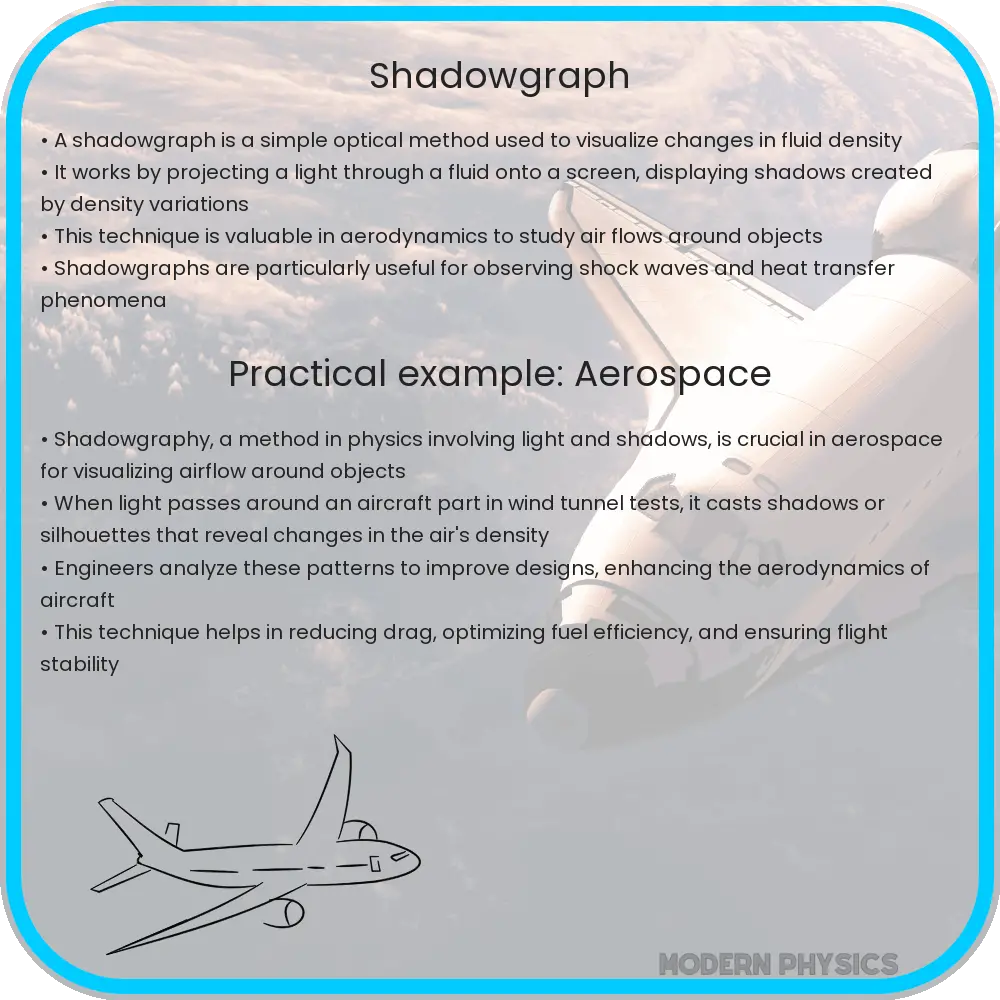Shadowgraph techniques utilize light and shadows to visualize patterns in fluid flows, shock waves, and transparent media for insights into density, temperature, and pressure changes.

Shadowgraph Techniques
Shadowgraph techniques are a fascinating and powerful set of tools in the field of experimental physics and engineering. These techniques allow us to visualize the patterns within fluid flows, shock waves, and other transparent inhomogeneous media. By using light and shadows, shadowgraph techniques can reveal detailed images of changes in density, temperature, and pressure within a medium, offering insights into complex dynamic processes.
Principles of Shadowgraphy
At its core, shadowgraphy relies on the principles of light propagation and refraction. When a beam of light passes through a transparent medium with varying refractive indices, slight deviations in the light path occur. These deviations create variations in the light intensity on a screen or photographic plate placed behind the medium. The resulting shadow patterns highlight regions of different densities, allowing us to “see” the invisible.
Basic Setup
A typical shadowgraph setup includes the following components:
- A coherent light source, such as a laser or a collimated beam
- A transparent medium through which the light passes
- A screen or a digital camera to capture the shadow patterns
The light source emits a beam that travels through the medium. As the light traverses regions with different refractive indices, it bends slightly. These deviations cause variations in light intensity on the screen or camera, forming the shadowgraph image.
Mathematical Representation
The foundation of shadowgraphy can be understood mathematically through the refractive index gradient ∇n. When light passes through an object with density variations, the light deflection angle θ is proportional to the refractive index gradient:
\[
\theta = \frac{dF}{dx}
\]
where:
- θ is the deflection angle
- F is the optical path length difference
- x is the distance along the path
The resulting light intensity pattern I on the screen is a function of the deflection angles:
\[
I(x, y) = I_0 e^{-\alpha ( \frac{d^2 F}{dx^2} + \frac{d^2 F}{dy^2} )}
\]
where α is a proportionality constant, and I\sub>0 is the initial light intensity.
Applications
Shadowgraph techniques find applications in a wide range of scientific and engineering disciplines:
- Aerodynamics: Visualizing shock waves and boundary layers around aircraft and projectiles
- Combustion studies: Observing flame fronts and turbulence in combustion chambers
- Medicine: Imaging fluid flow patterns in microchannels for biomedical research
- Meteorology: Studying atmospheric phenomena such as heat waves and convection currents
These applications showcase the versatility and utility of shadowgraph techniques in visualizing and understanding the hidden dynamics of various processes.
Advanced Techniques
While basic shadowgraph setups can reveal a lot about fluid dynamics and other phenomena, advanced techniques can provide even more detailed information. One such technique is the use of time-resolved shadowgraphy. By capturing a sequence of shadowgraph images at very short time intervals, scientists can generate high-speed videos that track the evolution of dynamic processes in real-time. This is particularly useful in studying rapid phenomena such as shock waves or explosive reactions.
Limitations and Challenges
Despite their many advantages, shadowgraph techniques have certain limitations. One of the main challenges is the reliance on a sufficiently transparent medium. If the medium is too opaque, the light cannot pass through effectively, and the resulting images will be unclear. Additionally, shadowgraphy primarily provides qualitative information. While it excels at showing the presence and general behavior of density gradients, it may not always offer precise quantitative measurements compared to other techniques like Schlieren photography or interferometry.
Comparison with Other Techniques
Shadowgraphy is often compared with techniques like Schlieren imaging and interferometry:
- Schlieren imaging: Similar to shadowgraphy but with higher sensitivity, making it capable of visualizing smaller refractive index changes. It also typically requires more complex optical setups, often involving knife edges or concave mirrors.
- Interferometry: Provides highly accurate quantitative measurements of refractive index variations. It uses the principle of interference between two coherent light beams and can measure minute changes in optical path length.
Depending on the requirements of the experiment, one technique may be preferred over the others. For instance, if high sensitivity and quantitative data are needed, Schlieren imaging or interferometry might be more suitable. However, for general visualization purposes, shadowgraphy remains a powerful and simpler tool.
Conclusion
In summary, shadowgraph techniques are invaluable tools in the fields of physics and engineering, offering a unique way to visualize and understand the dynamic behaviors of transparent media. By leveraging the fundamental principles of light refraction and propagation, these techniques can reveal intricate details about fluid flows, shock waves, and even atmospheric phenomena. Advanced methods like time-resolved shadowgraphy push the boundaries of what can be observed, while comparisons with Schlieren imaging and interferometry highlight the specific advantages and applications of each technique. Though not without their limitations, shadowgraph techniques continue to be essential in both research and practical applications, providing profound insights into the hidden dynamics of our world.
